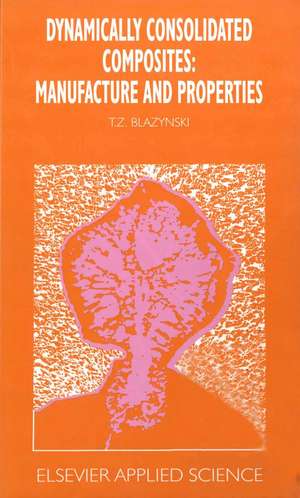Dynamically Consolidated Composites: Manufacture and Properties
Editat de T.Z. Blazynskien Limba Engleză Hardback – 29 feb 1992
Preț: 407.01 lei
Nou
Puncte Express: 611
Preț estimativ în valută:
77.91€ • 84.65$ • 65.48£
77.91€ • 84.65$ • 65.48£
Carte tipărită la comandă
Livrare economică 21 aprilie-05 mai
Preluare comenzi: 021 569.72.76
Specificații
ISBN-13: 9781851666096
ISBN-10: 1851666095
Pagini: 464
Ilustrații: XIII, 452 p.
Dimensiuni: 152 x 229 mm
Greutate: 0.86 kg
Ediția:1992
Editura: SPRINGER NETHERLANDS
Colecția Springer
Locul publicării:Dordrecht, Netherlands
ISBN-10: 1851666095
Pagini: 464
Ilustrații: XIII, 452 p.
Dimensiuni: 152 x 229 mm
Greutate: 0.86 kg
Ediția:1992
Editura: SPRINGER NETHERLANDS
Colecția Springer
Locul publicării:Dordrecht, Netherlands
Public țintă
ResearchCuprins
1. Concepts of Dynamic Processing.- 1.1 Introduction.- 1.2 Dynamic Processing Techniques.- 1.3 Range of Applications.- 1.4 Future Developments.- 2. Stress Waves and Material Response.- 2.1 Basic Characteristics of Generated Waves.- 2.2 Material Response.- 2.3 Shock Waves in Composites.- References.- 3. Solid Matter Composites.- 3.1 Introduction.- 3.2 Explosives and Detonation Phenomena.- 3.3 Characteristics of the Welding Mechanisms.- References.- 4. Explosive Welding Operations.- 4.1 Welding Systems.- 4.2 Planar Geometries.- 4.3 Axisymmetrical Geometries.- References.- 5. Forming of Composites.- 5.1 Classification of Forming Systems.- 5.2 Free Forming.- 5.3 Axisymmetrical Die Forming.- 5.4 Lining.- 5.5 Special Applications.- References.- 6. Particulate Matter Composites.- 6.1 Characteristic Features.- 6.2 Manufacturing Systems.- 6.3 Material Properties.- References.- 7. Shock Consolidation of Metallic Powders.- 7.1 Introduction.- 7.2 Properties of Single Shock-treated Materials.- 7.3 Properties of Metallic Composites.- References.- 8. Shock Treatment of Ceramic Powders.- 8.1 General Observations.- 8.2 Oxide-based Composites.- 8.3 Non-Oxide Ceramic Composites.- References.- 9. Shock Consolidation of Polymeric Powders.- 9.1 Introduction.- 9.2 Densification of Single Polymers.- 9.3 Polymeric Blends.- 9.4 Polymer-Ceramic Composites.- 9.5 Metalloplastics.- References.- 10. Cermets, Metallic Glasses and Superconductors.- 10.1 Introduction.- 10.2 Cermets.- 10.3 Metallic Glasses.- 10.4 Superconductors.- References.















